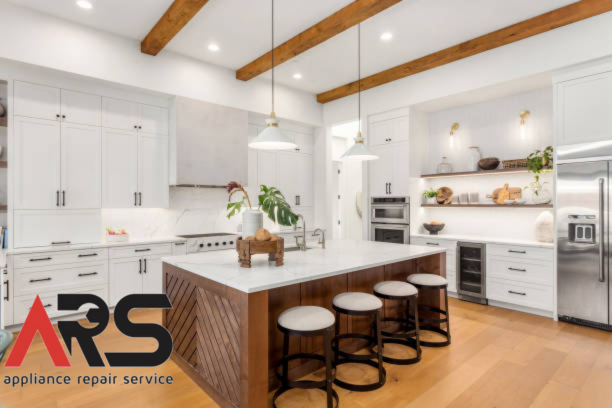
Appliance Maintenance
Appliance Maintenance is on the mind as the festive cheer begins to settle and the remnants of holiday celebrations are swept away, it’s time to turn our attention to the unsung heroes of our homes – our trusty appliances. At ARS Appliances Repair Service, nestled in the heart of Concord-Vaughan, Ontario, we understand the demands that seasonal festivities place on household appliances. The joyous chaos of gatherings, elaborate feasts, and extended usage can take a toll on these workhorses.
In this exclusive Boxing Day blog, we embark on a journey of post-holiday appliance care, delving into DIY fixes and preventive measures to ensure your appliances continue to serve you seamlessly. As we unwrap the intricacies of maintenance, we aim to empower you with practical insights beyond the festivities, helping you keep your home running smoothly throughout the year.
So, join us as we unwrap the secrets to preserving the life and efficiency of your appliances, turning the post-holiday season into an opportunity for rejuvenation and care. Let’s dive into the world of appliance maintenance and embark on a journey to keep the heart of your home in top-notch condition.
Common Post-Holiday Appliance Maintenance: Navigating Wear and Tear
As the last strains of holiday music fade away and the decorations return to storage, it’s not uncommon to discover that our appliances have undergone a marathon of use during the festivities. The increased load, whether from cooking extravagant meals or accommodating guests, can leave a trace of wear and tear on our reliable companions.
A. Increased Usage During Celebrations
The holiday season often translates into a surge in appliance usage. From the oven working overtime to prepare festive feasts to the washing machine handling an influx of holiday-themed linens, our appliances bear the brunt of our celebratory traditions. This heightened activity can lead to issues such as decreased efficiency, unusual noises, or even malfunctions.
B. Potential Wear and Tear
Beyond the immediate post-holiday hustle, the wear and tear inflicted during this period can have lasting effects. The wear on components, the strain on motors, and the accumulation of residues may not be immediately apparent, but they can silently compromise the longevity of your appliances. Recognizing these issues early on is key to maintaining the overall health of your home devices.
In the next section, we’ll explore practical DIY fixes for common post-holiday appliance problems, providing you with the tools to address issues promptly and efficiently. After all, a proactive approach to appliance care can save you both time and money in the long run. Stay tuned for expert insights and step-by-step guides to keep your appliances running like clockwork.
DIY Fixes for Common Problems: Empowering You to Tackle Post-Holiday Appliance Maintenance
Now that we’ve identified the common post-holiday issues, let’s roll up our sleeves and explore some hands-on, do-it-yourself fixes. Armed with some know-how, you can address these problems promptly and restore your appliances to their optimal state without needing immediate professional assistance.
A. Quick Troubleshooting Tips for Common Issues
- Refrigerator Repair: Combatting uneven cooling or strange noises.
- Oven Repair: Resolving temperature inconsistencies or faulty heating elements.
- Washing Machine Repair: Tackling drainage problems or sudden leaks.
- Dishwasher Repair: Dealing with poor cleaning performance or water not draining properly.
B. Step-by-step guides for Simple Repairs
- Unclogging the Drain: A simple guide to reviving a slow-draining sink or dishwasher.
- Calibrating Your Oven: Ensuring accurate temperature settings for perfect baking results.
- Cleaning Refrigerator Coils: A step-by-step process to enhance your fridge’s cooling efficiency.
- Replacing Washer Seals: DIY tips for addressing leaks in your washing machine.
Our step-by-step guides are designed to make appliance troubleshooting accessible, even for those with limited technical expertise. Remember, an ounce of DIY prevention can often save you a pound of repair costs down the line. Join us in the next section as we delve into proactive measures with preventive care tips, ensuring your appliances remain in peak condition long after the holiday festivities have subsided.
When it comes to common appliance issues, a bit of troubleshooting can go a long way in resolving problems without the need for immediate professional intervention. Here are quick troubleshooting tips for prevalent issues in some of your essential home appliances.
Refrigerator Repair: Combatting Uneven Cooling or Strange Noises
Symptoms:
- Uneven cooling, with some areas too cold or too warm.
- Unusual noises such as rattling, buzzing, or clicking.
Quick Troubleshooting Tips:
- Check Temperature Settings: Ensure the thermostat is set to the recommended temperature. Adjust if necessary.
- Clean Condenser Coils: Follow our earlier guide on cleaning refrigerator coils to enhance cooling efficiency.
- Inspect for Food Blockage: Ensure food items are not blocking vents or interfering with the proper closing of doors.
- Level the Refrigerator: Use a level to check if your refrigerator is sitting evenly on the floor, as uneven placement can impact cooling.
Oven Repair: Resolving Temperature Inconsistencies or Faulty Heating Elements
Symptoms:
- Baking results are uneven or take longer than usual.
- Visible damage to heating elements.
Quick Troubleshooting Tips:
- Calibrate the Oven: Follow our guide on calibrating your oven to ensure accurate temperature settings.
- Inspect Heating Elements: Check for visible signs of damage or malfunction. Replace if necessary.
- Check Door Seal: Ensure the oven door seal is intact. A damaged seal can lead to heat loss and uneven baking.
Washing Machine Repair: Tackling Drainage Problems or Sudden Leaks
Symptoms:
- Slow or blocked drainage.
- Water leaks during or after a wash cycle.
Quick Troubleshooting Tips:
- Unclog the Drain: Refer to our DIY guide on unclogging drains for both sinks and dishwashers.
- Inspect Hoses: Check for kinks or blockages in the hoses. Replace damaged hoses.
- Examine Pump Filter: Clean the pump filter, usually located at the front or bottom of the washing machine, to remove debris.
Dishwasher Repair: Dealing with Poor Cleaning Performance or Water Not Draining Properly
Symptoms:
- Dishes are not cleaned thoroughly.
- Standing water at the bottom of the dishwasher.
Quick Troubleshooting Tips:
- Clean Sprayer Arms: Remove and clean sprayer arms to ensure proper water circulation.
- Check for Debris: Inspect the dishwasher’s bottom for any food particles or debris. Clean if necessary.
- Unclog the Drain: Follow the steps in our DIY guide to address drainage issues.
These quick troubleshooting tips are designed to help you address common issues with your refrigerator, oven, washing machine, and dishwasher. If problems persist or if you’re uncertain about the solutions, don’t hesitate to contact professionals like ARS Appliances Repair Service for a thorough inspection and expert assistance. Stay tuned for more DIY guides and preventive care tips in our post-holiday appliance maintenance series.

ARS Appliance Repair Service has been trusted across Toronto, Ottawa, and Southern Ontario for over a decade. Our licensed, manufacturer-authorized technicians specialize in repairing all major household and commercial appliances with genuine parts and warranty-backed service. From refrigerators and washers to ovens, dishwashers, and more, we restore appliances quickly, professionally, and correctly the first time, earning the confidence of homeowners and businesses throughout the region.





